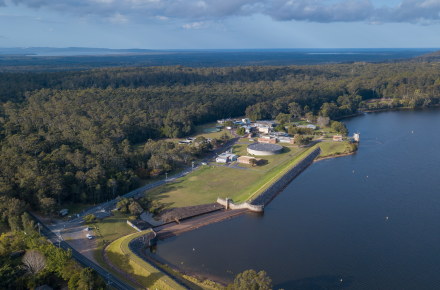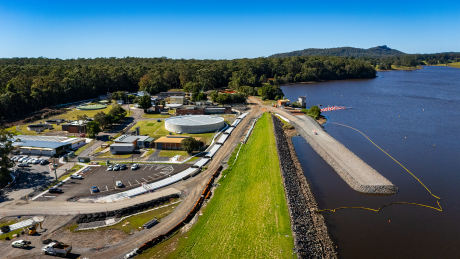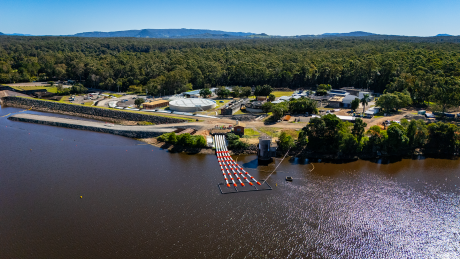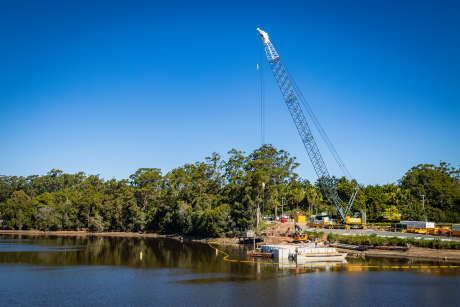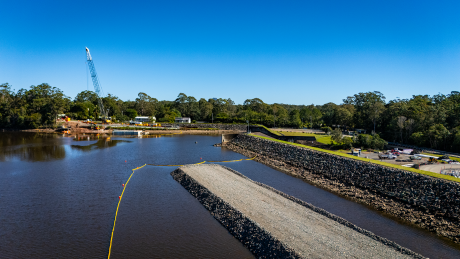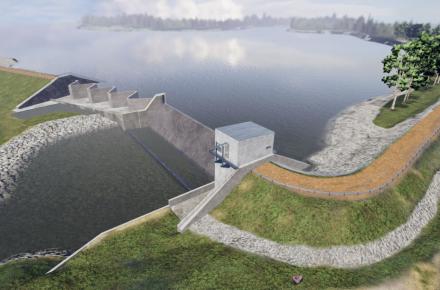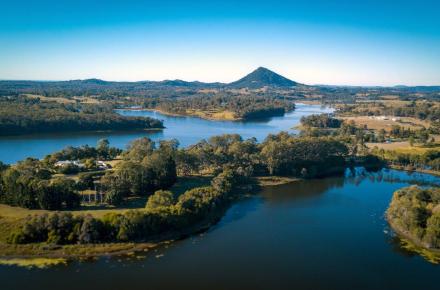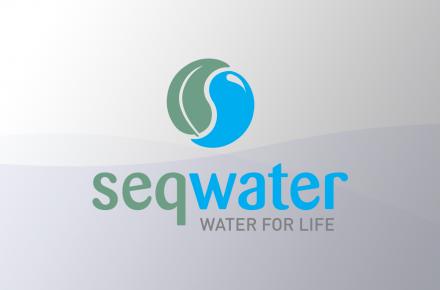
Lake Macdonald Dam Improvement Project
Seqwater is upgrading Noosa’s Lake Macdonald (Six Mile Creek) Dam as part of its Dam Improvement Program. Construction is underway.
About the project
Across Queensland and Australia, there are multiple dam upgrades occurring to meet modern engineering standards.
Seqwater’s Dam Improvement Program is ensuring its dams comply with the latest safety standards and continue to function safely during extreme weather events in line with regulatory requirements.
The Lake Macdonald Dam Improvement Project will include constructing a temporary upstream cofferdam, a new spillway and reconstructing the existing earth embankments.
We are proud to be partnered with John Holland as the major construction contractor for this essential project.
The enhancements will not only improve water supply reliability but also bolster the dam’s ability to manage extreme weather conditions, ensuring regulatory compliance now and in the future.
Early site establishment began in November 2024, with main construction activities now underway. The project is anticipated to take around five years to complete, depending on weather and site conditions.
Project update
Early site establishment began in November 2024, with main construction works now underway. Lake lowering transitioned to a larger siphon system in late May 2025, and will continue lowering the lake to the 39% level.
Construction on the temporary upstream cofferdam is concurrent with ongoing lake lowering.
For the latest information on the project click here.
Design
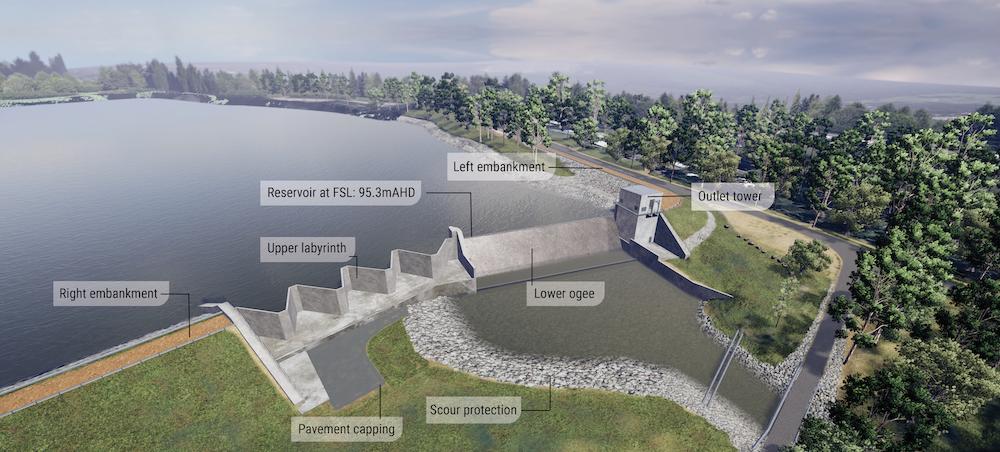
This image shows the new split level spillway layout, including the upper labyrinth spillway (zigzag portion of the dam wall), and the new embankment.
The design for the new dam wall at Lake Macdonald is a split-level concrete spillway. The primary 'lower ogee' spillway is set at the original lake level, and an upper labyrinth spillway for higher floods.
A labyrinth spillway is an overflow weir, zigzag in shape which creates a longer total effective length over the spillway to enable higher flows caused by large rain events. The labyrinth spillway provides an efficient means of increasing spillway capacity without raising the dam’s crest.
The earth embankments will be reconstructed to their original level on either side of the spillway.
Scour protection will be an addition, with rocks placed downstream of the spillway to prevent erosion.
An outlet tower will be constructed to the left side of the spillway which will have mechanical pipework and electrical components to facilitate both emergency release of water, to lower the dam reservoir, and environmental flows to the downstream Six Mile Creek.
At completion of the project, the new dam will have the same storage volume and full supply level as the existing dam (storage to 8,000ML).
Project scope
The Lake Macdonald Dam Improvement Project includes:
- Lowering the Lake Macdonald water storage to accommodate construction.
- Relocation of fish by expert fish biologists, via a purpose-built fish transport vehicle, to Cooloolabin Dam.
- Construction of a cofferdam to protect the site and manage flows in Six Mile Creek during construction.
- Demolition of the existing spillway and dam wall.
- Removal of unsuitable foundation material under the new spillway, excavating down to a rock foundation, then backfilling with mass concrete.
- Construction of a split-level concrete spillway. The primary spillway will be set at the original lake level, and an upper labyrinth spillway will be constructed for large floods.
- Removal and reconstruction of the earth embankments on either side of the primary spillway.
- Ground improvement works below the new embankments.
- Provision of a new outlet works structure to enable environmental releases downstream of the dam into Six Mile Creek.
Additional works include fish protection measures (including proposed construction of a fishway at Gympie Weir), land management activities and rehabilitation.
Upstream cofferdam
A cofferdam structure is being built to undertake the construction of the new dam wall safely. A cofferdam is an enclosure built within a body of water to allow the enclosed area to be pumped out or drained. The pumping creates a dry working environment so that the dam wall construction work can be carried out safely.
The cofferdam for the Lake Macdonald Dam Improvement Project will be:
- 300 metres long
- 10 metres wide
- Approximately the same height as the current dam wall.
This is a temporary measure for dam safety during construction and once the new dam wall is complete, the cofferdam will be removed, and the dam will naturally refill to its original full supply level.
Lake lowering
Seqwater has worked to minimise environmental impacts and maintain local water security during construction, with a revised construction methodology that will temporarily reduce the water level by approximately 2 metres, from the full supply level.
Technically speaking, Lake Macdonald will sit at about 39 per cent of its full supply level (or 92.8 metres AHD).
This reduced water level will allow the construction work to safely take place. The lake will remain at this level throughout construction unless dry conditions create a naturally lower level.
The Noosa Water Treatment Plant will continue to be operated as per the annual operating strategy and the monthly operational supply schedule (currently 20ML/d on average).
Community Reference Group
In 2024, the Lake Macdonald Dam Improvement Project re-established the Community Reference Group (CRG).
The purpose of the Lake Macdonald Dam Improvement Project CRG is to provide a formal channel for community input on issues of relevance and highlight any local concerns that may relate to the project. The group will also assist in the dissemination of information about the project throughout the region.
The meeting notes and presentation will be published below, following each CRG meeting:
- Meeting 1:
- Meeting 2:
- Meeting 3:
- Meeting 4:
Site Environmental Management Plan (SEMP)
The Site Environmental Management Plan (SEMP) specifies the requirements placed on Seqwater for the Lake Macdonald Dam Improvement Project that will be used to enhance environmental performance and comply with environmental requirements.
Site Environmental Management Plan (SEMP)
The SEMP has been developed to guide the implementation of the following Construction Environmental Sub-Plans:
- Stormwater Management Plan (LMDIP-05829-GNL-ENV-MPL-00002)
- Flora & Fauna (Terrestrial) Management Plan (LMDIP-05829-GNL-ENV-MPL-00003)
- Lighting Management Plan (LMDIP-05829-GNL-ENV-MPL-00004)
- Noise and Vibration Management Plan (LMDIP-05829-GNL-ENV-MPL-00005)
- Dust and Air Quality Management Plan (LMDIP-05829-GNL-ENV-MPL-00006)
- Community and Stakeholder Engagement Plan (LMDIP-05829-GNL-CMS-MPL-00001)
- Flora & Fauna (Dewatering) Management Plan (LMDIP-05327-GNL-ENV-MPL-00003)
- Traffic Management Plan (LMDIP-05806-ROD-TRR-MPL-00001)
- Weed and Pest Management Plan (LMDIP-05829-GNL-ENV-MPL-00009)
- Waste and Resource Use Management Plan (LMDIP-05829-GNL-ENV-MPL-00008)
- Hazardous Substances Management Plan (LMDIP-05829-GNL-ENV-MPL-00007)
- Cultural Heritage Management Plan (LMDIP-05829-GNL-CHE-MPL-00001)
- Adaptive Management Plan (LMDIP-05327-GNL-ENV-MPL-00002)
Contact the team
If you have any questions about the project, please see the project FAQs below, or get in contact with the project team.
Phone us 07 5472 1565
Email us [email protected]
Stay informed with project updates as this project progresses, by signing up to the newsletter subscription below.

- Project updates
- FAQs
- Resources
-
Community Newsletter - November 2025
6 Nov 2025
This newsletter provides the latest project information including construction and environmental updates. To read the newsletter, click here.
Work hours update for cofferdam construction
20 Oct 2025
We would like to advise select activities critical to progress of cofferdam construction will occur between 6:30am – 4:00pm Sundays, from 19 October 2025 until the cofferdam structure is complete.
These activities are essential to keep the project running efficiently during standard working hours. We are committed to keeping noise and inconvenience to a minimum and appreciate your patience and understanding as we complete these important works.
Click here to view the full works notice.
Community Newsletter - August 2025
6 Aug 2025
This newsletter provides the latest project information including construction and environmental updates. To read the newsletter, click here.
Construction commences on Lake Macdonald Dam upgrade
19 Jun 2025
Seqwater has commenced construction to upgrade Lake Macdonald Dam, a key project in its Dam Improvement Program, to ensure the dam meets modern engineering and design standards to ensure it continues to operate safely and provide water security for years to come.
The Lake Macdonald Dam Improvement Project includes construction of a temporary cofferdam, a new concrete spillway, an upper labyrinth, and the reconstruction of the existing earth embankments to enhance the dam’s ability to withstand extreme weather events.
Seqwater Executive General Manager Infrastructure Planning and Capital Delivery, Sarah Dixon, said while Lake Macdonald Dam continues to operate safely under normal conditions, Seqwater is committed to investing in the longevity of the important local water source.
“Lake Macdonald Dam was built in 1965 to the safety standards of its time, but the methods used to estimate extreme weather and flood risks have changed significantly since the dam was originally built,” she said.
“Seqwater is proud to mark a major milestone in starting construction on the Lake Macdonald Dam Improvement Project together with our head contractor John Holland. The dam upgrade will continue to ensure long-term water supply reliability for the Sunshine Coast region,” said Dixon.
The large siphon system has been switched on and is partially lowering the lake to allow the works to be undertaken safely. Works have also commenced on the temporary upstream cofferdam, with a 250-tonne crane onsite.
More than 1,500 tonnes of sheet piles are being delivered to form the structure of the cofferdam, and more than 3,000 rock bags - each weighing approximately 8 tonnes - are being placed downstream of the cofferdam to provide additional structural support.
In addition, more than 80,000 tonnes of rockfill is being delivered to build the cofferdam.
This will be the first major upgrade of Lake Macdonald Dam since its raise in 1980. Importantly, more than 150 jobs are expected to be supported over the life of the project.
Standard work hours are Monday to Friday, from 6:30am to 6:30pm, and Saturday from 6:30am to 4:00pm. Extended work hours will be required for some construction activities, including spillway demolition.
During construction, there will be an increase in traffic around Lake Macdonald. Temporary traffic changes will occur, and traffic controllers and temporary signage will be in place when required.
Recreation activities on Lake Macdonald via Lake Macdonald Park and the Noosa Botanic Gardens will remain open, however some recreational use of the lake and surrounding areas will be temporarily closed for safety due to proximity to the construction area.
Seqwater extends its thanks to the community for their ongoing patience and support during this essential dam safety and water security upgrade and is committed to providing regular updates to keep residents informed as work progresses.
The Lake Macdonald Dam Improvement Project is expected to take about five years to complete, weather and site conditions permitting.
To connect with a member of the Seqwater project team, email [email protected] or call 07 3432 7000 (during business hours).
To stay up to date, visit the Seqwater website.
Further Information:
Through its Dam Improvement Program, Seqwater is investing in South East Queensland’s dams to ensure they provide water security for years to come.
Since 2008, Seqwater has delivered 13 upgrades, including Leslie Harrison Dam at Capalaba, Sideling Creek Dam north of Brisbane and Ewen Maddock Dam on the Sunshine Coast.
Lake lowering and cofferdam construction update
17 Apr 2025
Project approvals for the main construction works are currently being finalised. Once approved, the Lake Macdonald Dam Improvement Project Team will progress with transitioning to a larger siphon system and commence construction on the temporary upstream cofferdam.
More information on the upcoming works is available here.
Community Engagement Summary | March 2025
20 Mar 2025
This engagement summary provides a summary on the feedback received from the community events held in January and February 2025. To the read the summary, click here.
Community Newsletter – January 2025
20 Jan 2025
This newsletter provides the latest project information on Jan-Feb 2025 community events, the construction schedule and construction impacts. To read the newsletter, click here.
Project Update Community Newsletter - December 2024
19 Dec 2024
This newsletter provides the latest project information and project updates for the months of October-December 2024 as well as a look ahead to major construction in 2025. To read the newsletter, click here.
Invitation for submissions - Project change applications – Construction
16 Dec 2024
The Lake Macdonald Dam Improvement Project team submitted a project change application to the Coordinator-General relating to proposed changes to the temporary cofferdam design for water security reasons.
The Coordinator-General is inviting the community to make a submission on the proposed changes to the project.
The application is available online at Six Mile Creek Dam Safety Upgrade project | State Development, Infrastructure and Planning.
Submissions open on Monday 16 December 2024 and will close on Tuesday 28 January 2025.
To make a submission, please visit:
- Online: https://haveyoursay.dsd.qld.gov.au
- Email: [email protected]
- Post: Attention: The Coordinator-General
c/- Project Manager - Six Mile Creek Dam Safety Upgrade Project
Office of the Coordinator-General
PO Box 15517
City East Qld 4002 Australia
Lake Macdonald Dam Improvement Project Community Reference Group - Expressions of interest now open
4 Nov 2024
Seqwater is inviting expressions of interest from the community to participate in the reformed Lake Macdonald Dam Improvement Project Community Reference Group (CRG).
The purpose of the Lake Macdonald Dam Improvement Project CRG is to provide a formal channel for community input on issues of relevance and highlight any local concerns that may relate to the project. The group will also assist in the dissemination of information about the project throughout the region.
The Lake Macdonald Dam Improvement Project CRG will:
- Provide input to ongoing project planning to ensure both community and Seqwater needs are represented, project impacts are understood and addressed, where possible, and any opportunities and benefits are considered and maximised.
- Assist in refining the potential social impacts of the project and possible mitigation measures by confirming or updating information provided by the former CRG in 2019.
- Actively involve the community and key stakeholders in planning to ensure the project delivery meets community expectations, including for the proposed coffer dam.
- Raise awareness and understanding of the project in the community through the active sharing of information between well informed CRG members and their local networks.
- Improve Seqwater’s understanding of community impacts and concerns related to the project.
We’re seeking applications and looking for a variety of community members such as those who live near the dam, live upstream or downstream of the dam, local businesses, and/or have a heritage or environmental interest. Being on the CRG is a voluntary, unpaid position, and will require a commitment of some personal time.
To learn more about the CRG and selection criteria, read the Terms of Reference and the Selection Criteria.
Nominations will be open for a two-week period from Monday 4 November 2024 to Sunday 17 November 2024.
The first Community Reference Group meeting will be held local to Lake Macdonald Dam on Tuesday 3 December from 3:30pm – 5:30pm. It is expected that the successful applicants will be available to attend the meeting in person on this date. Information on the meeting location will be provided to successful applicants.
To apply to be a Lake Macdonald Dam Improvement Project CRG member, complete the application below or email [email protected].
Lake Macdonald DIP | Community Newsletter | August 2024
1 Aug 2024
Seqwater’s Lake Macdonald Dam Improvement Project is progressing, with detailed planning and onsite works continuing in 2024. Read the August community newsletter for the latest updates.
-
About the project
Why does Lake Macdonald Dam need to be upgraded?Lake Macdonald – also known as Six Mile Creek Dam – was originally constructed in 1965.
There have been significant advances in dam design since the dam was built, as well as new ways of estimating extreme rainfall and flood events, and a greater understanding of the size and severity of earthquakes.
This will be the first major upgrade of the dam since the wall was raised in 1980. The Lake Macdonald Dam Improvement Project will:
- increase the spillway capacity to safely pass floods
- protect the dam wall in extreme flood events
- efficiently control water flowing out of the dam
- reduce risks to the dam structure during earthquakes
- meet modern design and engineering standards
- comply with dam safety guidelines.
Is the dam currently safe?All Seqwater dams within the Dam Improvement Program continue to operate safely. Dam improvements are undertaken to meet modern guidelines for these life-long assets – many of which were built some years ago.
Seqwater undertakes regular monitoring and engineering assessments to ensure all our dams continue to operate safely.
Dams in Queensland were built to high, internationally accepted safety standards. However, the methodologies and data used to estimate extreme weather events and flooding impacts have significantly improved, and engineering standards and risks have progressed.
All these factors are considered as part of Seqwater’s Dam Improvement Program so our dams continue to operate as they should, now and into the future.
Construction timeframe and activities
What is involved in the construction?Main construction works commenced in May 2025. Most work will be completed during approved standard working hours to reduce impacts to the community.
Day work
- Monday to Friday – 6.30am to 6.30pm
- Saturday – 6.30am to 4.00pm
Some work activities are time critical and must be carried out continuously or outside of the approved standard hours for safety and construction reasons. More information is available on our work hours fact sheet.
Construction activities to expect in 2025 include the mobilisation of stockpiled rock and other materials and equipment, piling equipment mobilised onsite for cofferdam construction, and lake lowering and cofferdam construction.
The entire construction process, from building the cofferdam to its removal after the new dam wall is complete, is anticipated to take around five years, depending on weather and site conditions.
Key activities will include:
- Vibratory and Impact piling
- Concrete and rock breaking
- Earthworks
- Concrete pours
- Rock filling.
Please note that the construction schedule is subject to change based on environmental and operational factors.
How long will the dam upgrade take?The entire construction process, from building the cofferdam to its removal after the new dam wall is complete, is anticipated to take around five years, subject to weather and construction conditions.
Construction phases and timeframes are:
- Phase 1 (2025) – Construction of temporary cofferdam
- Phase 2 (2025-2026) – Demolition of existing dam wall
- Phase 3 (2026-2028) – Construction of new dam wall and infrastructure
- Phase 4 (2028-2029) – Remove cofferdam and site rehabilitation.
Lake Macdonald Dam will naturally refill to its original full supply level once construction is complete.
Where will the construction materials come from for the cofferdam and how will they be managed?John Holland have procured four quarries to supply materials on-site and these quarries will be used as required, based on their material availability, material suitability and site requirements.
Quarries approved for use are:
- Boral (Moy Pocket)
- Cordwell's (Kin Kin)
- Corbett's (Traveston)
- Holcim (Bli Bli).
Control measures for quarry trucks on the Lake Macdonald Dam Improvement Project include:
- Trucks to be fitted with GPS tracking to monitor truck speeds and haulage route.
- Signage and UHF for school buses to communicate and coordinate movements on the road.
- Sign in and sign out system, including QR code registration, to track and monitor trucks.
- Boom gate system to stagger truck movements travelling between the quarry and project site.
- Heavy vehicle movements will be minimised during school pick-up/drop-off times (7:20-8:45am and 2.30-3:45pm).
Community and construction impacts
What impacts can be expected during construction and mitigation measures will be in place?The community can expect an increase in standard construction impacts intermittently throughout the project including noise, dust, vibration and increased heavy vehicle movements.
At times, out of hours work including weekend, night and continuous work will be required to complete time critical activities.
We will provide advance notice to the community and stakeholders ahead of any out-of-hours works. Additionally, we will actively engage and inform the community prior to the commencement of key construction activities.
We understand some activities will be more disruptive for residents in close proximity to the project, and will remain available 24/7 to those directly affected.
Click to read our fact sheets for more information on traffic management, work hours, and noise, dust and vibration mitigation measures.
We thank the community for the patience and understanding they are showing while these essential works are carried out.
Environmental management
How will impacts to the natural flora and fauna be mitigated?We are working closely with qualified ecologists to ensure the well-being of local flora and fauna, implementing targeted measures to protect and manage wildlife throughout the construction period.
To date, Seqwater and John Holland have carried out extensive environmental investigations to identify and document plant and animal habitats in and around Lake Macdonald.
These investigations have included detailed field surveys focused on protected plant species, key habitats for native wildlife, aquatic ecosystems, and significant local species. The process also involved reviewing historical and current reports and databases to ensure a comprehensive understanding of the area’s ecological values.
Click here for more information on our ecological management and mitigation measures.
Will fish relocation be undertaken?During the lake drawdown, there will be a temporary reduction in available habitat for aquatic species. To help minimise ecological impacts, the project team initiated an aquatic fauna relocation program targeting identified native fish species.
In July 2025, approximately 680 fish were successfully salvaged and relocated by specialist fish biologists. The relocation was carried out using a purpose-built transport vehicle, with the fish transferred to Cooloolabin Dam to preserve aquatic biodiversity and support ecosystem resilience.
The species relocated included Australian bass, eel-tailed catfish, and longfin eels. Additionally, one Mary River Cod was captured, genetically sampled, measured, and released into the Mary River to support conservation efforts for this iconic species.
Will a fish ladder be included in the upgrade?There is no existing fish passage (a fish ladder is a specific type of fish passage) at Lake Macdonald Dam, and no proposed fish passage included in the Lake Macdonald Dam Improvement Project. The reasons for this are:
- A fish passage could allow for pest species such as Tilapia to enter Lake Macdonald reservoir.
- A more suitable location for a fish passage has been identified at the Gympie Weir. A fish passage in this location will allow fish to pass up and down the main Mary River, allowing passage between the upper tributaries and reaches.
- The Coordinator-General, as part of the Project Approval Conditions, has stated that Seqwater upgrade the Gympie Weir to include a fish passage.
Recreation and public access
What impacts will there be to recreation areas?Lake Macdonald is expected to remain open to on-water recreation, and parks and facilities recreation throughout the project.
Lake Macdonald, Lake Macdonald Park / Perch Park and the boat ramp along Lake Macdonald Drive will remain open, as well as the Noosa Botanic Gardens. Recreation activities including motorless boating, canoeing and fishing will be permitted outside of the construction zone, which the cofferdam will isolate.
The scouts campground, the Mary River Cod Park and boat ramp, the fishing platform on Lake Macdonald Drive and some walking, riding and horse trails are temporarily closed for the duration of construction.
The Noosa Trail Network will remain open, however access points to the trails may change during construction. Vehicle parking and foot access will be closed at the Lake Macdonald Drive trail head (near Kookaburra Park) and along Collwood Road due to construction activities.
To view the latest recreation notices for Lake Macdonald please visit the Seqwater recreation alerts page.
-
Video
LAKE MACDONALD ANIMATION
FileNoise, Dust & Vibration
FileFlora and fauna
FileTraffic management
FileWork hours
FileCommunity update - August 2024
FileLake Macdonald Additional Lake Lowering.pdf
FileCommunity Engagement Summary - May 2024
VideoMaking controlled water releases from dams and pipelines
VideoSeqwater explains: six stages of a dam safety upgrade
VideoUnderstanding the SEQ Water Grid
FileLake Macdonald Dam Improvement Project - Monitoring Report - August 2025.pdf
